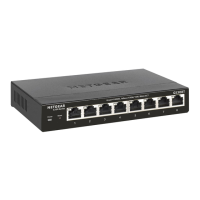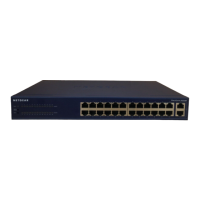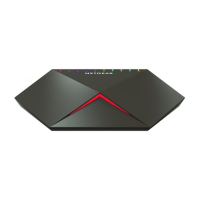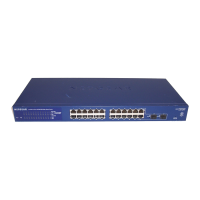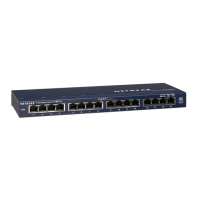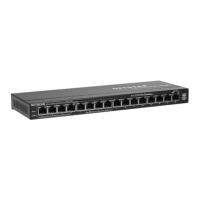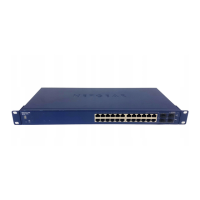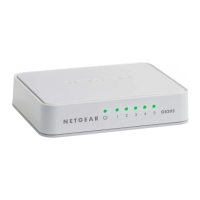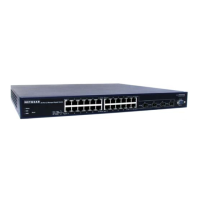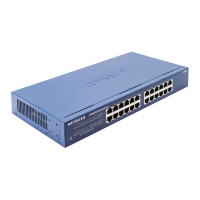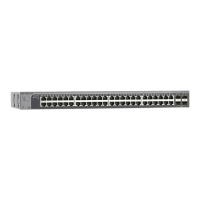
Do you have a question about the NETGEAR S3300 and is the answer not in the manual?
| Model | NETGEAR S3300 |
|---|---|
| Category | Switch |
| VLAN Support | Yes |
| Quality of Service (QoS) | Yes |
| MAC Address Table Size | 16K |
| Uplink Ports | 4 x 10G SFP+ |
| Switching Capacity | 128 Gbps |
| Forwarding Rate | 95.2 Mpps |
| Layer | Layer 2+/Layer 3 Lite |
| Management | Web-based GUI, SNMP |
| Dimensions | 440 x 257 x 43 mm (17.32 x 10.12 x 1.69 in) |
| Jumbo Frame Support | Yes |
| Operating Temperature | 0°C to 50°C (32°F to 122°F) |
| Storage Temperature | -20°C to 70°C (-4°F to 158°F) |
| Humidity | 90% maximum relative humidity, noncondensing |
| Power Supply | Internal power supply |
| Power Consumption | Varies by model |
| Ports | 24 or 48 x 10/100/1000BASE-T |
| Weight | 3.60 kg (7.94 lb) |
Overview of the embedded web server and management software for managing and monitoring switch functions.
Steps to connect the switch to the network and configure network information for remote management.
How to set up your switch in a network with a DHCP server using Smart Control Center.
How to set up your switch in a network without a DHCP server using Smart Control Center.
Steps to configure the IP address of the administrative system to be on the same subnet as the switch.
Methods to access the switch management interface using a web browser.
How to configure interface settings, applying them to single ports, multiple ports, or all ports.
Configure and view general device information, including system name, location, and contact details.
Overview of stackable switches, stack manager responsibilities, and member identification.
Configure system-level PoE parameters per unit, including usage threshold and power management.
Configure Simple Network Management Protocol (SNMP) version 1 and version 2 information.
Configure Link Layer Discovery Protocol (LLDP) and LLDP-MED parameters applied globally.
Configure DHCP L2 Relay, DHCP snooping, DHCPv6 snooping, and Dynamic ARP Inspection features.
Define timer schedules for use with PoE/PoE+ features and associate them with ports.
Combine multiple full-duplex Ethernet links into a single logical link for fault tolerance and load sharing.
Add virtual LAN (VLAN) support to a Layer 2 switch for network segmentation and security.
Provides a tree topology to prevent loops in bridged networks, supporting Common STP, Multiple STP, and Rapid STP.
Configure IEEE 802.1AS for QoS requirements and precise clock synchronization.
Configure and display IP routing data, including IP configuration for the switch.
Configure switch software to support VLAN routing, enabling inter-VLAN communication.
Configure the address resolution protocol (ARP) to associate Layer 2 MAC addresses with Layer 3 IPv4 addresses.
Configure switch queueing aspects to provide desired QoS behavior for different traffic types.
Configure DiffServ support for traffic classification and priority, giving preferential treatment.
Configure login password, RADIUS, TACACS+, and authentication lists for management security.
Configure global port access control settings using 802.1X, including port-based authentication.
Configure MAC Filters, Storm Control, Port Security, and Protected Port settings.
Define classification actions and rules for specific ingress ports to control traffic flow and enhance security.
Reboot the switch or reset the system configuration to factory default values.
Export system file configurations, logs, or tech support files to a remote system via TFTP or HTTP.
Download system files, such as software images or configurations, from a remote system to the switch.
Perform basic troubleshooting functions like pinging and tracing routes to diagnose network issues.
View and monitor physical port information, traffic statistics, and cable test results.
Display detailed statistical information about the traffic handled by the switch.
View a summary of per-port traffic statistics on the switch.
View event messages, memory logs, FLASH logs, server logs, and trap logs for system monitoring.
Example demonstrating VLAN use, port membership, and tagged/untagged traffic handling.
Example of configuring DiffServ classes, policies, and services for traffic classification.
Example showing how to configure 802.1X-based authentication for port access control.
Procedure for upgrading firmware to support mixed stacking between M4300 and S3300 models.
Details the switch features, performance, and conformance to networking standards.
Provides default values and states for various switch features and parameters.
